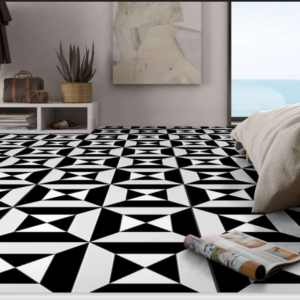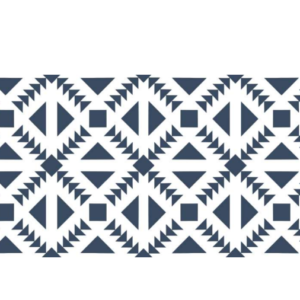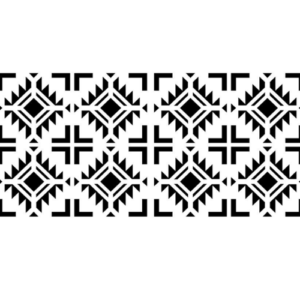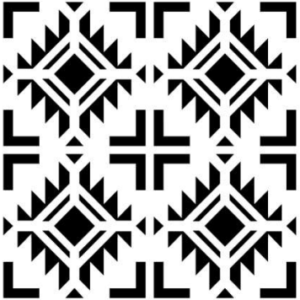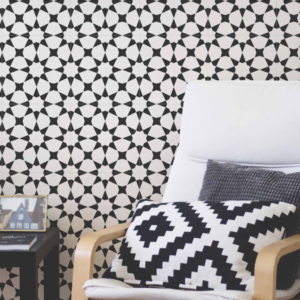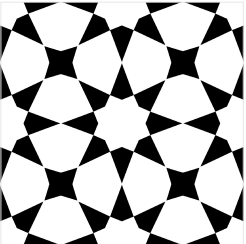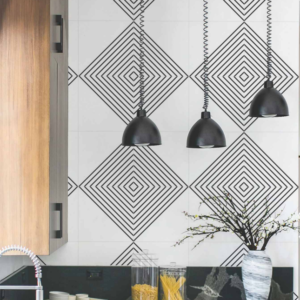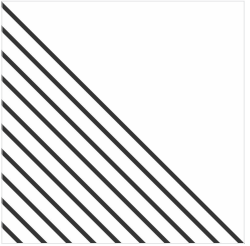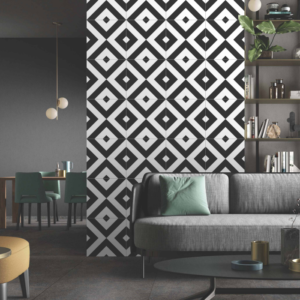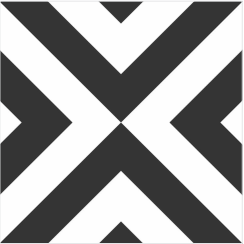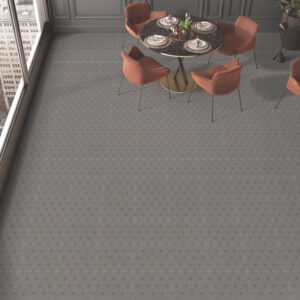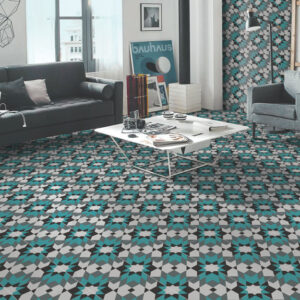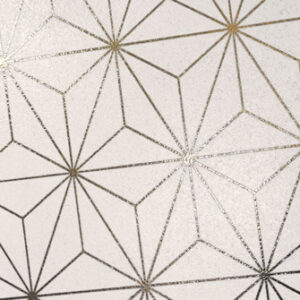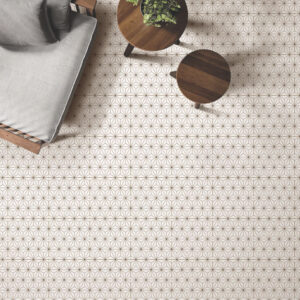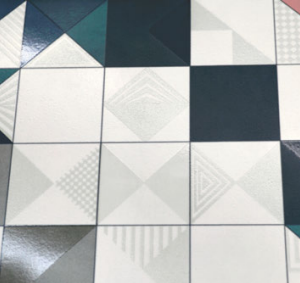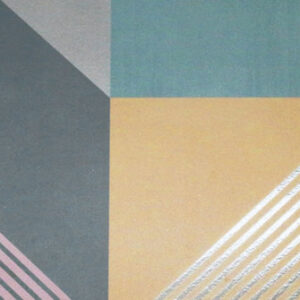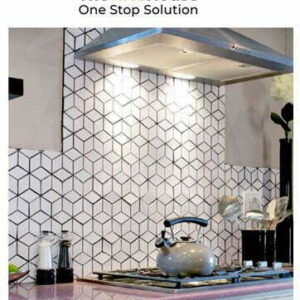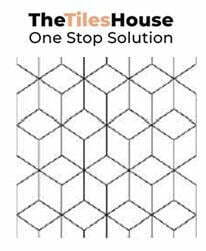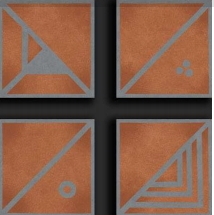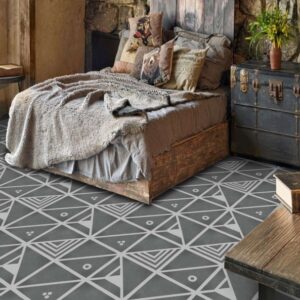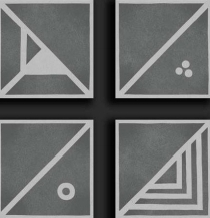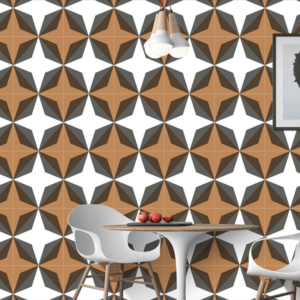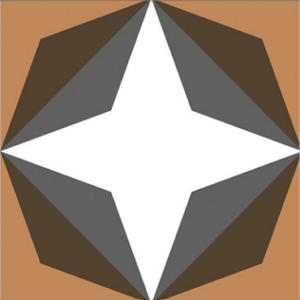GEOMETRIC TILES
Geometric tile’s bold movement, recognizable shapes, and energizing patterns let you create a statement in any area. These tiles are the design itself; they are not merely an accent to it. Squares, rectangles, triangles, polygons, hexagons, and diamonds are examples of geometric shapes. The uses for geometric tile are virtually limitless because it comes in so many distinct forms and varieties.
Geometric Tile Design Ideas
Depending on your style, the impression of geometric tiles might be strong or more understated. Compared to a dark green tile with a triangular design, a white tile with hexagon shapes is more understated. They nevertheless serve as the focal point of the space because to their striking arrangement. This keeps the remaining décor subdued and neutral.
Geometric Backsplash Tiles
Geometric backsplash tiles are elevated by our elegant range of polished glass tiles. The tiles are either
triangular or brick-shaped, and while they seem perfectly flat on the outside, the inside of each one has a beveled edge. This seemingly little element catches the light, giving the appearance of an optical illusion by adding depth and dimension.
Floor Tiles with Geometry
What could liven up a room more than a few geometric floor tiles? They offer depth in addition to producing an eye-catching pattern that will draw the viewer in. Consider huge waterjet tiles with very large patterns.
Vintage Styles Tiles
Geometric floor tiles can be used to create retro-inspired themes; think about using black and white pieces. There are variations on the traditional penny round, such as hexagon-shaped ones, which give a room a retro feel.
Natural Stone Selections
Nothing compares to the combination of a striking geometric pattern and real stone. It’s the most effective method for designing a striking floor area. Imagine a through-body brass inlay set into a deep, nero marquina marble; it’s sophisticated and sophisticated.
Look through our geometric tile patterns to discover the ideal tile to add some pattern and dimension to your space and make it stand out. We provide a large assortment of materials for you to pick from, whether you’re looking for glass, stone, mosaic, or ceramic tiles.
Types of Geometric Tiles
1. Ceramic Geometric Tiles:
Widely available and Suitable for walls and floors in low to moderate traffic.
2. Porcelain Geometric Tiles:
Denser and more durable than Ideal for high-traffic areas and spaces exposed to.
3. Cement Geometric Tiles:
Offer a unique, artisanal look with vibrant colors and intricate Suitable for both indoor and outdoor.
4. Natural Stone Geometric Tiles:
Made from materials like marble, granite, and offer a luxurious and timeless.
5. Glass Geometric Tiles:
Provide a sleek and contemporary often used for backsplashes and accent.
FAQs
What are the benefits of using geometric tiles in bathrooms?
Geometric tiles offer several advantages for bathrooms, both aesthetic and functional:
Visual Appeal and Design Versatility:
• Unique and Eye-catching: Geometric patterns add a touch of personality and break away from the monotony of plain tiles. They can elevate the look of your bathroom from basic to modern, contemporary, or even retro, depending on the chosen pattern and colors.
• Variety of Patterns and Styles: With a vast array of shapes (hexagons, chevrons, Moroccan trellis etc.), sizes, and colors, geometric tiles offer endless design possibilities. You can create a bold statement wall, a subtle geometric accent on the floor, or even a playful mix-and-match approach.
• Creates Depth and Dimension: The interplay of lines and shapes in geometric patterns adds visual interest and can create an illusion of depth and dimension in your bathroom, especially valuable in smaller spaces.
Functionality and Practicality:
• Can Hide Imperfections: Geometric patterns can cleverly disguise minor imperfections on walls or unevenness on floors, especially when using smaller geometric tiles or busier patterns.
• Easier Cleaning in Certain Patterns: Some geometric patterns, like herringbone or basketweave, can create grout lines that are less noticeable than a simple grid pattern. This can make cleaning the tiles slightly easier as dirt and grime buildup might be less apparent.
How do I choose the right geometric tile design for my space?
Choosing the right geometric tile design for your bathroom involves considering several factors to create a cohesive and visually appealing space. Here’s a roadmap to guide your selection:
1. Assess Your Bathroom’s Size and Layout:
• Small Bathroom: Opt for smaller geometric tiles or patterns with a lighter color palette to avoid overwhelming the space. Simple patterns like hexagons or herringbone can add visual interest without making the room feel crowded.
• Large Bathroom: You have more freedom to explore! Larger geometric tiles or bolder patterns can create a dramatic statement. Consider chevrons, Moroccan trellis, or even a mix-and-match approach using complementary patterns.
2. Consider the Overall Style of Your Bathroom:
• Modern or Contemporary: Geometric tiles are a natural fit for these styles. Explore bold patterns, contrasting colors, or even metallic accents.
• Traditional: Opt for classic geometric patterns like herringbone or chevron in neutral colors or natural stone materials for a timeless look.
• Mid-Century Modern: Terrazzo tiles with geometric chips or classic basketweave patterns in muted tones can evoke this era’s aesthetic.
• Scandinavian Minimalist: Keep it clean and simple with white or light-colored geometric tiles in a subtle pattern like hexagons or a minimalist herringbone.
3. Think About the Feeling You Want to Create:
• Energetic and Stimulating: Bold colors, contrasting grout lines, or a busy geometric pattern can add energy to your bathroom.
• Relaxing and Spa-Like: Opt for muted colors, natural stone materials, or a calming geometric pattern like a wave motif in soft tones.
• Playful and Fun: Experiment with a mix-and-match approach using complementary geometric shapes and colors for a unique and personal touch.
4. Inspiration and Planning:
• Online Resources: Look for bathroom design inspiration online. Websites like Pinterest, Houzz, or design blogs showcase a vast array of geometric tile applications in various styles.
• Showroom Visits: Visit tile showrooms or bathroom design centers to see geometric tiles in person. This allows you to experience the textures, colors, and scale of the tiles firsthand.
• Create a Mood Board: Gather images, color swatches, and material samples that resonate with your vision. Experiment with different combinations to visualize the final look.
5. Professional Help:
• Interior Designer: Consulting with an interior designer can be beneficial, especially for intricate designs or if you’re unsure about balancing colors and patterns.
• Tile Installer: Getting advice from an experienced tile installer can be helpful. They can suggest patterns that are easier to work with and ensure a professional finish.
Are geometric tiles easy to clean and maintain?
The ease of cleaning and maintaining geometric bathroom tiles depends on several factors:
Tile Material:
• Ceramic or Porcelain: These are generally easy to clean and maintain. They are resistant to moisture, mold, and mildew, making them ideal for bathrooms. Regular wiping with a damp cloth and occasional cleaning with a non-abrasive bathroom cleaner will suffice.
• Natural Stone: Tiles like slate or granite can add a touch of luxury but require more care. They might need to be sealed periodically to protect against moisture and staining. Consult cleaning recommendations specific to the chosen stone type.
Grout Lines:
• Pattern Complexity: Intricate geometric patterns with a lot of grout lines might require more effort to clean, especially if the grout color is light. Dirt and grime buildup can be more noticeable. Simpler patterns with less grout area may be easier to maintain.
• Grout Color: Darker grout lines tend to show less dirt and grime buildup compared to lighter grout colors. However, keep in mind that darker grouts might not complement all design styles.
Do geometric tiles come in different colors and sizes?
Absolutely! Geometric bathroom tiles come in a vast array of colors and sizes, offering endless design possibilities. Here’s a breakdown of the variety you can expect:
Color Palette:
• Classic Neutrals: White, black, beige, and gray are timeless choices that complement various bathroom styles. These neutral colors can be a great base for bolder geometric patterns or create a clean, minimalist look.
• Bold and Vibrant: If you want a statement bathroom, explore geometric tiles in jewel tones like emerald green, sapphire blue, or ruby red. These colors can add energy and create a dramatic focal point.
• Muted and Earthy: For a spa-like atmosphere, consider muted tones like sage green, light blue, or taupe. These colors create a calming and serene ambiance.
• Metallic Accents: Metallic finishes like gold, silver, or copper can add a touch of luxury to your bathroom. Geometric tiles with metallic accents can work well in modern or contemporary designs.
Size Variations:
• Small Mosaic Tiles: These are perfect for creating intricate geometric patterns or adding a textured accent. They work well on shower floors or small bathroom walls.
• Medium-Sized Tiles: A versatile option that can be used for floors, walls, or even shower surrounds. They offer a good balance between creating a patterned look and not overwhelming the space.
• Large-Format Tiles: Ideal for creating a seamless and modern look in larger bathrooms. These can minimize grout lines and make the space feel more expansive.
Combining Colors and Sizes:
• Monochromatic: Use different shades of the same color within a geometric pattern for a sophisticated look.
• Complementary Colors: Choose geometric tiles in colors that complement each other on the color wheel, like blue and orange or green and red, for a vibrant and eye- catching design.
• Mix and Match: Experiment with combining different geometric shapes and sizes in complementary colors for a playful and unique approach.
Active Filters:
Clear Filters
-
Delta Vitrified Moroccan Tile 24*48 Inch
₹90.00/ Sqft -
Taos Vitrified Moroccan Tile 24*48 Inch
₹90.00/ Sqft -
Elvi Vitrified Moroccan Tile 24*48 Inch
₹90.00/ Sqft -
M-10121 Ceramic Moroccan Tile 12*12 Inch
₹75.00/ Sqft -
M-10128 Ceramic Moroccan Tile 12*12 Inch
₹75.00/ Sqft -
M-10129 Ceramic Moroccan Tile 12*12 Inch
₹75.00/ Sqft -
30218 Tubo Vitrified Moroccan Tile 12×12 Inch
₹400.00/ Sqft
Showing all 16 results


